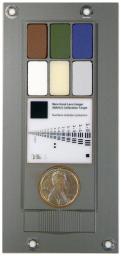
|
Full-Scale Image of MAHLI Calibration Target
- Click the image above for a larger view
- Full-Res JPEG (676 x 1436) (188.3 kB)
- Full-Res TIFF (676 x 1436) (2.9 MB)
Caption:
This image provides a way to have a full-size printout of the calibration target for the Mars Hand Lens Imager (MAHLI) camera on NASA's Mars rover Curiosity.
The MAHLI calibration target includes color chips, a metric standardized bar graphic, a penny, and a stair-step pattern for depth calibration. The MAHLI adjustable-focus, color camera is one of the tools on the turret at the end of Curiosity's robotic arm. Its calibration target is attached to the rover at the arm's shoulder joint.
This image is sized at 8.5 inches by 11 inches. Send it to a printer for paper of that size; ignore the protest that parts of the image are outside the printable area. Print it. Set a penny on the image of the calibration target's penny. If your penny and the printed image are the same size, you did it correctly. This print shows you the actual size of the MAHLI calibration target.
Patches of pigmented silicone on the upper portion of the MAHLI target serve as aids for interpreting color and brightness in images. Five of them -- red, green, blue, 40-percent gray and 60-percent gray -- are spares from calibration targets for the Panoramic Camera on NASA's Mars rovers Spirit and Opportunity. The sixth contains a fluorescent pigment that glows red when an ultraviolet light source on MAHLI shines on it.
The target's bar graphic is adapted from a standardized U.S. Air Force chart for testing camera resolution. Numbers on it refer to how many of the black-white cycles fit into one millimeter. For example, in the largest set of bars, labeled 1.0, each black bar is one-half millimeter wide and each white space between bars is another one-half millimeter. One millimeter is about 0.04 inch. Applied Image Inc., Rochester, N.Y., made the portion of the MAHLI calibration target with this chart and other graphics on opal glass. One of the graphics, just above the left edge of the penny, is a tiny cartoon figure called "Joe the Martian."
The penny is from 1909, the first year Lincoln pennies were minted and the centennial of Abraham Lincoln's birth. Including it on the calibration target is a nod to geologists' tradition of placing a coin as a size reference in close-up photographs of rocks. It gives the public a familiar object for perceiving size easily.
MAHLI can provide three-dimensional information by taking a series of images at different focal ranges or by moving the camera between two images to yield stereo-pair images. The stair-step pattern at the bottom of the target, plus the penny, help with three-dimensional calibration using known surface shapes.
NASA's Mars Science Laboratory mission launched on Nov. 26, 2011, and will deliver the rover Curiosity to Gale Crater on Mars in August 2012. With MAHLI and nine other science instruments, Curiosity will investigate whether the area has ever offered environmental conditions favorable for microbial life.
Background Info:
Malin Space Science Systems, San Diego, supplied MAHLI and three other cameras for the mission. NASA's Jet Propulsion Laboratory, a division of the California Institute of Technology, in Pasadena, manages the Mars Science Laboratory mission for the NASA Science Mission Directorate, Washington, and built Curiosity.
Cataloging Keywords:
| Name | Value | Additional Values |
|---|---|---|
| Target | Mars | |
| System | ||
| Target Type | Planet | |
| Mission | Mars Science Laboratory (MSL) | Mars Exploration Rover (MER) |
| Instrument Host | Curiosity Rover | Opportunity (MER-B), Spirit (MER-A) |
| Host Type | Rover | |
| Instrument | Mars Hand Lens Imager (MAHLI) | |
| Detector | ||
| Extra Keywords | Color, Crater, Ultraviolet | |
| Acquisition Date | ||
| Release Date | 2012-02-07 | |
| Date in Caption | 2011-11-26 | |
| Image Credit | NASA/JPL-Caltech/Malin Space Science Systems | |
| Source | photojournal.jpl.nasa.gov/catalog/PIA15286 | |
| Identifier | PIA15286 | |
